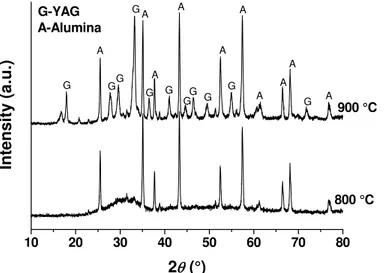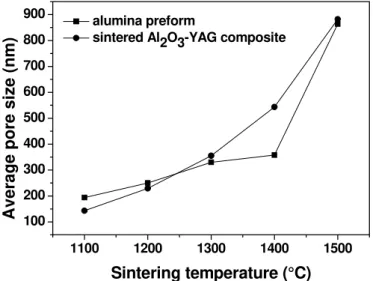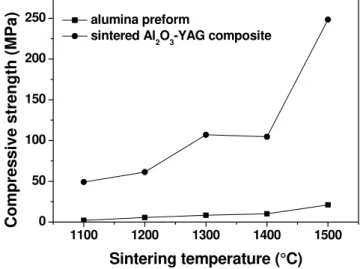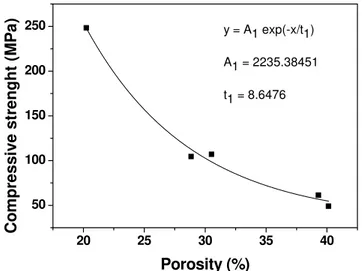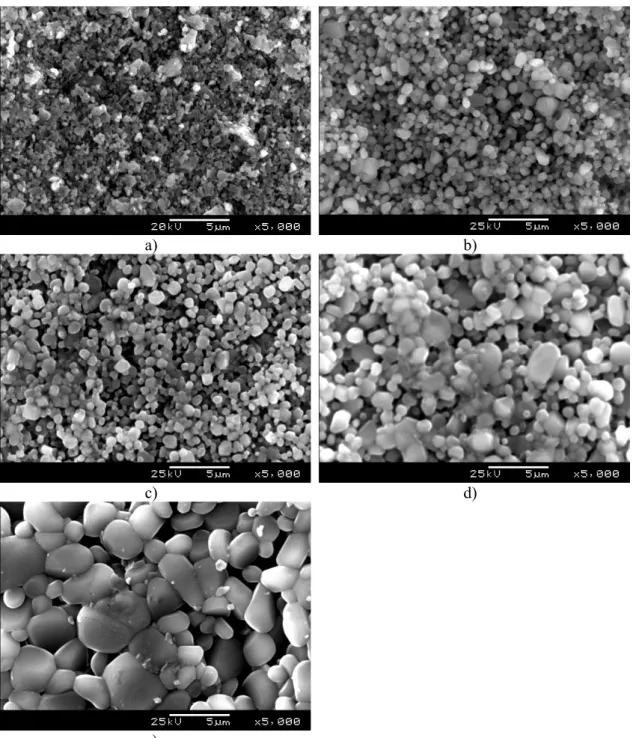_____________________________
*)Corresponding author: adela@vinca.rs
doi: 10.2298/SOS1603303E
UDK 692.533.1; 546.62; 622.785
Synthesis of Highly Porous Al
2O
3-YAG Composite Ceramics
Adela Egelja
1*), Jelena Majstorovi
ć
2, Nikola Vukovi
ć
2, Miroslav
Stankovi
ć
3, Dušan Bu
č
evac
11
Vin
č
a Institute of Nuclear Sciences, University of Belgrade, P.O. Box 522, 11001
Belgrade, Serbia
2
Faculty of Mining and Geology, University of Belgrade, Djušina 7, 11000 Belgrade,
Serbia
3
IHTM, University of Belgrade, Studentski trg 12-16, 11000 Belgrade, Serbia
Abstract:
Al2O3-YAG composite was obtained by sintering of porous Al2O3 preforms infiltrated
with water solution of aluminium nitrate nonahydrate, Al(NO3)3·9H2O and yttrium nitrate
hexahydrate, Y(NO3)3·6H2O. Al2O3 preforms with porosity varying from 26 to 50% were
obtained after sintering at temperature ranging from 1100 to 1500 °C. Sintering of the infiltrated Al2O3 preforms led to formation of YAG particles due to reaction betweenY2O3 and
Al2O3 at high temperature. It was found that variation of porosity of alumina preforms and
sintering temperature is an effective way to fabricate Al2O3-YAG composite with an unusual
combination of properties. Open porosity was in the range 15-35%, specific surface was 0.6-6.1 m2/g, pore size was 150-900 nm whereas compressive strength was from 50 to 250 MPa. The effect of sintering temperature on YAG formation and phase composition were investigated using X-ray diffractometry whereas microstructure of the composite was analysed by scanning electron microscopy.
Keywords: Al2O3-YAG, Porous ceramics, Composites.
1. Introduction
Good combination of chemical, thermal, mechanical and electrical properties make alumina (Al2O3) one of the most frequently used structural materials especially when it comes
to industrial application [1]. In general, oxide ceramics have been considered less suitable for high temperature application then non-oxide ceramics due to degradation of mechanical properties at high temperature [2]. On the other side, oxide ceramics, such as alumina, have oxidation and corrosion resistance superior to any other ceramics. Bearing this in mind it is expected that the improvement of high temperature mechanical properties such as strength and fracture toughness will allow oxide ceramics to be effectively used in a wide range of applications at high temperature [2-5]. It is well documented that mechanical properties of alumina can be improved by incorporation of the second phase inclusions into alumina matrix [6, 7]. Yttrium aluminium garnet (YAG) or 3Y2O3·5Al2O3 is one of the possible reinforcing
phases because of its excellent creep resistance, similar coefficient of thermal expansion and no reaction with alumina [8, 9]. There are three crystal phases in the Al2O3-Y2O3 system,
possesses the highest aluminium content and therefore the highest stability in contact with alumina [6-8]. The influence of YAG content ranging from 5 to 30 vol.% on the mechanical properties and microstructure of Al2O3-YAG composites was investigated by Lach et al.
[6-8]. The highest values of mechanical properties such as fracture toughness, strength and hardness were measured in samples containing 10 vol. % YAG, sintered at 1600 oC. However, there are various applications of oxide ceramics when the components are not exposed to excessive load and therefore superior mechanical properties are not the key demand. It would be important to point out porous ceramics which are of significant interest due to their wide application in high-temperature filtration and absorption, catalysis and catalyst support, thermal insulation, thermal gas separation, lightweight structural as well as thermal structural application [5, 12]. The key properties of porous ceramics used in high temperature environment are high melting point, low thermal conductivity, chemical inertness, open pore structure; especially pore size distribution and decent mechanical properties which allow easy handling and machining without excessive chipping.
There are different routes and different precursors of alumina and Y2O3 (yttria) which
has been used to fabricate Al2O3-YAG composite. Alumina and yttria powders can be simply
mixed by mechanical mixing [13] which can be either dry or wet. This method requires extensive ball milling which usually introduces considerable amount of impurities [9, 13]. Somewhat better homogenization of aluminium and yttrium atoms is usually provided by using water solution of alumina and yttrium precursors. For example, aluminium and yttrium nitrates or chlorides were used in co-precipitation method which is considered as time consuming process [6-9]. Sol-gel technique should also be mentioned as a method of Al2O3
-YAG composite preparation. This technique is based on the use of corresponding alcoxides which are usually quite expensive [9]. Palmero et al. prepared Al2O3-5 vol. % YAG
composite from commercial α-alumina powders and aqueous solutions of YCl3·6H2O [1, 14].
Different routes of preparing alumina-yttrium system lead to a variety of microstructures with different properties.
In the present work, porous Al2O3-YAG composites were fabricated by infiltration of
alumina performs with water solution of aluminium nitrate and yttrium nitrate. The technique is based on precipitation of alumina and yttrium precursors within porous alumina compacts. The properties and composition of Al2O3-YAG composites were varied by changing the
porosity of alumina performs and sintering temperature. According to our knowledge this method has not been investigated by other researchers.
2. Experimental
High purity Al2O3 powder (CT3000-SG, Alcoa) was pressed under mechanical
pressure of 10 MPa into cylinders with diameter of 16 mm. In order to fabricate alumina performs with different porosity, powder compacts were sintered for 2h at five different temperatures: 1100, 1200, 1300, 1400, and 1500 °C. This heat treatment will be denoted as perform sintering. After the cylinders were vacuumed in vacuum chamber for about 30 minutes they were dripped with water solution of aluminium nitrate nonahydrate, Al(NO3)3·9H2O and yttrium nitrate hexahydrate, Y(NO3)3·6H2O with concentration of 0.38
g/cm3 and 0.23 g/cm3, respectively. The samples were dried at 120 °C for 4 h to remove water
and subsequently calcined at 700 °C for 2 h to remove nitrogen. The procedure of vacuuming, dripping, drying and calcination was repeated six times to increase the aluminium and yttrium content in Al2O3 performs. Hereafter, this six-step procedure will be called infiltration. The
samples were afterwards sintered again for 3 h in order to transform aluminium and yttrium containing compounds into YAG. The temperature of final sintering was equal to the temperature of alumina perform sintering. Powder compacts consisting of commercial Al2O3
-Y2O3 diagram [10, 13], the present fraction of Y2O3 in powder compacts is expected to give
Al2O3-YAG composite with 15 vol. % YAG. The samples were sintered at 1000 and 1100 °C
for 3 h. Density and open porosity of the obtained samples were measured by applying Archimedes’ method in xylene and referred to the theoretical density (TD) using 3.97 g/cm3 for alumina [15] and 4.56 g/cm3 for Y3Al5O12 [16]. The crystalline phases were identified by
X-ray diffraction (XRD) analysis using filtered Cu Kα radiation (Siemens D5000). Young’s modulus was determined by the ultrasonic method (SONIC viewer - MODEL 5210) using following equation [17]:
dyn dyn dyn dyn
V
E
μ
μ
μ
ρ
−
⋅
−
+
⋅
⋅
=
1
)
2
1
)(
1
(
2 (1)where V is the pulse velocity, ρ is the bulk density (kg/m3), and µdyn is the dynamic Poisson’s
ratio. The microstructure analysis was conducted on polished and thermally etched surface by means of scanning electron microscopy (SEM) (JEOL JCM-5800). Prior to the examination the surface was coated with a thin layer of gold. Since the samples were highly porous, the size of individual grains was determined by simple measuring and averaging the grain diameter in vertical and horizontal direction. Open porosity, pore volume, average pore radius as well as specific surface were measured by mercury porosimetry (Porosimeter 2000 Series, Fisions Instruments). Compressive strength measurement was carried out using uniaxial compressive test on Universal testing machine INSTRON 1185.
3. Results and discussion
3.1 Phase identification
Fig. 1 shows the XRD patterns of infiltrated alumina performs sintered at different temperature. The figure indicates that temperature of 1100 oC is sufficient to cause transformation of aluminium and yttrium containing compounds within alumina performs into YAG. As can be seen, the sample sintered at 1100 oCas well as samples sintered at higher temperature consist of Al2O3 and YAG. The phase composition of sintered samples is
presented in Tab. I. Volume fractions of Al2O3 and YAG were calculated in two different
ways. The first way is based on the intensity of XRD peaks of sintered samples whereas the second way is based on the increase in mass of alumina performs after infiltration and final sintering. It was assumed that sintering at high temperature completely removes water and nitrogen from infiltrated nitrates while Al, Y and O, present in the residue, finally make YAG.
G- YAG A- Alumina 1500 °C 1400 °C 1300 °C 1200 °C 1100 °C
2θ (°)
Intensity (a.u.) G A A A A A A G G G G G G
G GG
G G
A
10 20 30 40 50 60 70 80
Tab. I Volume fraction of Al2O3 and YAG in samples calculated from XRD peaks and mass
increase.
Volume fraction (%)
XRD peaks Mass increase
Sintering temperature
(°C) Al2O3 YAG Al2O3 YAG
1100 84.5 15.5 85.4 14.6 1200 86.3 13.7 86.4 13.6 1300 90.9 9.1 91.1 8.9 1400 90.6 9.4 91.6 8.4 1500 92.1 7.9 95.8 4.2 *sintering temperature of infiltrated alumina preforms is equal to the sintering temperature of
alumina preforms
10 20 30 40 50 60 70 80
A A
A
A A
A G G
G G G A
G A G A G
G G
Intensit
y (a
.u.)
2θ (°)
800 °C 900 °C
G A
G-YAG A-Alumina
Fig. 2. XRD patterns of infiltrated alumina perform pieces sintered at 800 oC and 900 oC.
Therefore the increase in weight of alumina performs is equivalent to the amount of newly formed YAG. The values presented in Tab. I show a good agreement between the phase compositions determined by two different approaches. It is evident that the fraction of YAG decreases with an increase in sintering temperature. This is the result of decrease in porosity of alumina performs with sintering temperature, which will be discussed latter. As expected, the reduced porosity of alumina compacts obtained at high temperature leads to smaller amount of infiltrated nitrates and therefore smaller fraction of YAG in the sintered composite. As mentioned before, temperature of 1100 oC was sufficient to cause formation of YAG. Now the question arises as what is the lowest temperature at which YAG can be formed. The alumina performs sintered at temperature below 1100 oC were very fragile and they simply fell apart during infiltration. However, the alumina perform pieces were soaked in nitrates solution and thermally treated at temperature below 1100 oC. It was found that YAG crystallizes between 800 and 900 oC (Fig. 2).
Now, one can argue that the same composite material can be obtained by simple sintering of compacts consisting of Al2O3 and Y2O3. For this reason compacts of alumina
containing amount of Y2O3 expected to yield 15 vol. % of YAG were sintered at temperature
ranging from 900 to 1100 oC. Volume fraction of YAG of 15% was chosen as that was the largest amount of Y2O3 measured in sample obtained by nitrates infiltration. XRD diagram
given in Fig. 3 indicates that formation of YAG in samples consisting of commercial alumina and yttrium powders occurs between 1000 and 1100 oC. Even at 1100 oC, there is still small amount of unreacted Y2O3 indicating that the infiltration of aluminum and yttrium nitrates in
In addition, small amount of YAM (Y4Al2O9) side product was also detected in samples
obtained by sintering of oxides.
10 20 30 40 50 60 70 80
A
M Y Y
Y
Y Y
A A A
A A
A A
M
In
te
nsity (
a
.u.)
2θ (°)
1000 °C 1100 °C
A
Y G
A- Alumina Y- Yttria M- YAM G- YAG
Fig. 3. XRD patterns of alumina/yttrium samples sintered at 1000˚C and 1100 ˚C for 3h.
3.2. Density, porosity and pore characteristics
As mentioned, during the infiltration procedure, the pores of alumina performs were filled with YAG precursor which transformed into YAG during final sintering. From this point of view the composition of YAG precursor is not of great importance and therefore a detail analysis was not conducted. Based on the XRD pattern given in Fig. 2 which shows that YAG precursor is amorphous after heating at 800 oC it is believed that YAG precursor consists of well mixed aluminum, yttrium and oxygen atoms. This disordered structure transforms into crystalline YAG phase during sintering process owing to increased atom mobility and reactivity at high temperature. Fig. 4 describes the effect of sintering temperature on density of alumina performs as well as the effect of infiltration and final sintering on density of the Al2O3-YAG composite. As expected, the increase in sintering
temperature was an effective way to obtain alumina performs with gradually increasing density, from 1.9 g/cm3 in sample sintered at 1100 oC to 2.93 g/cm3 in sample sintered at 1500
oC. It can also be seen that the six-step infiltration of alumina performs considerably increases
the density of samples whereas the effect of final sintering on the increase of density is minimal.
1100 1200 1300 1400 1500 2,0
2,2 2,4 2,6 2,8 3,0 3,2
Densit
y (g/cm
3 )
Sintering temperature (°C) alumina preform
infiltrated alumina preform sintered Al2O3-YAG composite
In order to explain the infiltration process it would be of great importance to analyze the change of open porosity which is presented in Fig. 5. Unlike density, open porosity of alumina performs continuously decreases with an increase in sintering temperature from 50% in perform obtained at 1100 oC to 25% in perform obtained at 1500 oC. As expected, the infiltration reduces porosity since the pores are filled with infiltrated YAG precursor. It is interesting to note that the porosity increases after final sintering despite the fact that the change of density is almost negligible (Fig. 4). This unexpected finding can be explained by the shrinkage of amorphous YAG precursor during sintering. The crystallization of amorphous YAG precursor which fills the pores in alumina perform is accompanied with structure reordering which is followed by shrinkage of YAG precursor and separation of newly crystallized YAG particle from the wall of the pore in alumina perform. Thus, the separation introduces an additional open porosity in Al2O3-YAG composite. Finally, the
obtained composites have open porosity ranging from 40% in sample sintered at 1100 oC to 20% in sample sintered at 1500 oC. The above mentioned separation of YAG particle from pore wall was also followed by creation of new surface which should have led to an increase in specific surface.
1100 1200 1300 1400 1500
15 20 25 30 35 40 45 50
Open poro
s
ity (%)
Sintering temperature (°C)
alumina preform
infiltrated alumina preform sintered Al2O3-YAG composite
Fig. 5. Effect of temperature on open porosity of alumina performs, infiltrated performs and Al2O3-YAG composite.
1100 1200 1300 1400 1500
0 1 2 3 4 5 6 7
Speci
fi
c sur
fac
e
(
m
2 /g
)
Sintering temperature (°C) alumina preform
sintered Al2O3-YAG composite
Fig. 6. Effect of temperature on specific surface of alumina performs and Al2O3-YAG
Fig. 6 presents the specific surface of alumina performs and Al2O3-YAG composite sintered
at different temperatures. It is worth noting that at 1500 oC the specific surface of Al2O3-YAG
composite is larger than that of alumina perform. This means that despite the fact that the performs were infiltrated with YAG and open porosity decreased (Fig. 5) the specific surface of the Al2O3-YAG composite increased due to shrinkage of infiltrated material during
sintering and consequent separation of YAG particles from alumina wall. According to Fig. 6, it can be concluded that the separation effect is more pronounced at high temperature owing to larger shrinkage of YAG particles. At lower temperature, between 1100 and 1400 oC, the effect of separation is less exaggerated and specific surface of Al2O3-YAG composite is just
slightly lower than that of alumina perform.
1100 1200 1300 1400 1500
100 200 300 400 500 600 700 800 900
Aver
ag
e
p
o
re size (n
m
)
Sintering temperature (°C) alumina preform
sintered Al2O3-YAG composite
Fig. 7. Effect of temperature on average pore size of alumina performs and Al2O3-YAG
composite.
Tab. II Shrinkage of alumina performs after infiltration and sintering at different temperature (difference between diameters (r) of alumina performs/cylinders and obtained composites).
Sintering
temperature (°C) 1100 1200 1300 1400 1500 Shrinkage (Δr)
(%) 0.6 0.9 7.0 7.9 13.3
3.3. Young’s modulus and compressive strength
It is well known that porosity strongly affects Young’s modulus. The values of Young’s modulus, determined by the ultrasonic velocity method, are presented in Fig. 8 which shows that after infiltration procedure Young’s modulus of all samples increases due to the decrease in porosity (Fig. 4). Besides Young’s modulus, compressive strength is also strongly influenced by porosity.
1100 1200 1300 1400 1500
0 5 10 15 20 25 30 35 40
Yo
un
g's mod
u
l
(GPa)
Sintering temperature (°C)
alumina preform
infiltrated alumina preform sintered Al2O3-YAG composite
Fig. 8. Effect of temperature on Young’s modulus of alumina performs, infiltrated performs and Al2O3-YAG composite.
1100 1200 1300 1400 1500
0 50 100 150 200 250
Co
mp
res
s
ive str
e
ngth (M
Pa)
Sintering temperature (°C) alumina preform
sintered Al
2O3-YAG composite
Fig. 9. Effect of temperature on compressive strength of alumina performs and Al2O3-YAG
composite.
sintering temperature as the result of the increase in density. Furthermore, the infiltration and subsequent sintering of these performs significantly improve compressive strength. The strength of composite sintered at 1500 oC is about 250 MPa which is considerably higher than that of alumina performs (~ 20 MPa). This is expected knowing that infiltration of YAG decreases porosity, i.e., increases density. Strength (σp) and porosity (P) are related by the
following empirical relationship [18]:
σp= σ0e-BP (2)
where σ0 is the strength of the pore free material and B is a constant that depends on the
distribution and morphology of the pores. According to the equation the reduction of porosity results in an exponential increase in compressive strength. This kind of relationship was also found in this study. The measured values for compressive strength which are presented in Fig. 9 are fitted to an exponential function (Fig. 10). It was found that the strength of pore free material is ~ 2235 MPa which is within the range of values measured in commercially available alumina ceramics [19].
20 25 30 35 40
50 100 150 200 250
Co
mp
ress
iv
e s
tr
e
n
g
h
t (M
P
a
)
Porosity (%)
y = A1 exp(-x/t1)
A1 = 2235.38451
t1 = 8.6476
Fig. 10. Effect of porosity on compressive strength of Al2O3-YAG composite.
3.4. Microstructure
Fig. 11 shows the scanning electron microscopy (SEM) images of Al2O3-YAG
composite obtained at different temperatures. As can be seen, the average grain size continuously increases with sintering temperature from bellow 1 μm in sample sintered at 1100 oC to ~ 3 μm in sample sintered at 1500 oC. Again, this is quite expected bearing in mind that high temperature promotes sintering and therefore grain growth. In samples sintered at 1200, 1300 and 1400 °C the size of spherical grains is in the range of 0.2-2.0, 0.3-2.5 and 0.4-4.5 μm, respectively. Although it is evident that sintering takes place in these samples, the grains are still weakly bonded. At higher temperature such as 1500 oC the grains are much larger (0.7-7 μm) and bonded more rigidly which resulted in considerable increase in compressive strength (Fig. 9).
EDS. The EDS spectrum, given in Fig. 12b, reveals that this grain is YAG as it contains Y, Al and O. The presence of gold (Au) in EDS spectrum comes from thin layer of gold coating. This finding suggests that YAG phase in Al2O3-YAG composite should be white or at least
brighter than alumina. SEM micrograph and yttrium mapping micrograph of sample sintered at 1500 oC are given in Fig. 13. Careful comparison of SEM image (Fig. 13a) and image of yttrium distribution (Fig. 13b) allows identification of YAG phase. It appears that submicron YAG grains are located among large alumina grains (arrows in Fig. 13a). This is expected knowing that pores in alumina performs obtained at 1500 oC were ~850 nm in diameter. It is evident that the size of YAG grains is close to the size of pores in alumina performs simply due to limited space available for infiltration of YAG precursors.
a) b)
c) d)
e)
Fig. 11. SEM images of Al2O3-YAG composites obtained at a) 1100 °C; b) 1200 °C; c) 1300
a) b) Fig. 12. a) SEM-BSE image and b) EDS spectrum of composite sintered at 1200 oC.
a) b) Fig. 13. a) SEM-BSE image and b) YKα (yttrium) mapping images by SEM-EDS method of
sample sintered at 1500 oC.
4. Conclusions
Porous Al2O3-YAG composites were prepared by infiltration and precipitation
Acknowledgement
This work is supported by the Ministry of Education, Science and Technological Development of the Republic of Serbia under grant No. 45012.
5. References
1. P. Palmero, G. Fantozzi, F. Lomello, G. Bonnefont, L. Montanaro, Ceramics International 38 (2012) 433-441.
2. S. Ochiaia, T. Uedaa, K. Satoa, M. Hojoa, Y. Wakub, N. Nakagawac, S. Sakatab, A. Mitanib, T. Takahashib, Composites Science and Technology 61 (2001) 2117–2128. 3. S. Wang, T. Akatsu, Y. Tanabe, E. Yasuda, J. European Ceramic Society 20 (2000)
39-43.
4. H. Nozawa, T.Yanagitani, T. Nishimura and H. Tanaka, J. Ceramic Society of Japan 116 (5) (2008) 649-652.
5. J. S. Magdevski, J. University of Chemical Technology and Metallurgy, 45 (2) (2010) 143-148.
6. R. Lach, K. Haberko, M.M. Bućko, M. Szumera, G. Grabowski, J. European Ceramic Society 31 (2011) 1889–1895.
7. R. Lach, K. Haberko, M. Bućko, Processing and Application of Ceramics 5 (4) (2011) 187-191
8. R.Lach, K. Haberko, B. Trybalska, Processing and Application of Ceramics 4 (1) (2010) 1-6.
9. S. A. Hassanzadeh-Tabrizi, E. Taheri-Nassaj, H. Sarpoolaky, J. Alloys and Compounds 456 (2008) 282–285.
10. A. S. Gandhi, C. G. Levi, J. Material Research 20 (4) (2005) 1017-1025.
11. V. Lojpur, A. Egelja, J. Pantić, V. Djordjević, B. Matović, M. D. Dramićanin, Science of Sintering 46 (2014) 75-82.
12. C. Hong, X. Zhang, J. Han, S. Meng, S. Du, Ceramic Materials – Progress in Modern Ceramics 6 (2012) 109-128.
13. J. Alkebro, S. Begin-Colin, A. Mocellin, R. Warren, J. European Ceramic Society 20 (2000) 2169-2174.
14. P. Palmero, F. Lomello, G. Fantozzi, G. Bonnefont, Ceramic Materials 62 (4) (2010), 533-539.
15. J. A. Dean, Lange’s handbook of chemistry, 15th Edition.
16. D. R. Lide,Handbook of chemistry and physics, 84th Edition, CRC press, 2003. 17. S. Martinović, M. Vlahović, M. Dojčinović, T. Volkov-Husović, J. Majstorović, Int.
J. Applied Ceramic Technology 8 (5) (2011) 1115-1124.
18. M. W. Barsoum, Fundamental of ceramics, International Editions, 1997.
19. https://www.ceramtec.com/ceramic-materials/aluminum-oxide/
Са р а: Al2O3-YAG ј ј Al2O3
( ) ј
Al(NO3)3·9H2O ј Y(NO3)3·6H2O.
Al2O3 ј
1100 1500 °C ј 26 50%. С Al2O3
ј YAG ј ђ Y2O3 Al2O3
Al2O3-YAG
ј . ј 15-35%,
0.6-6.1 m2/g, 150-900 nm, ј 50 250 МP . У ј
YAG - , ј
ј ј .
К учн р чи: Al2O3-YAG, , .
© 2016 Authors. Published by the International Institute for the Science of Sintering. This article is an open access article distributed under the terms and conditions of the Creative Commons — Attribution 4.0 International license

